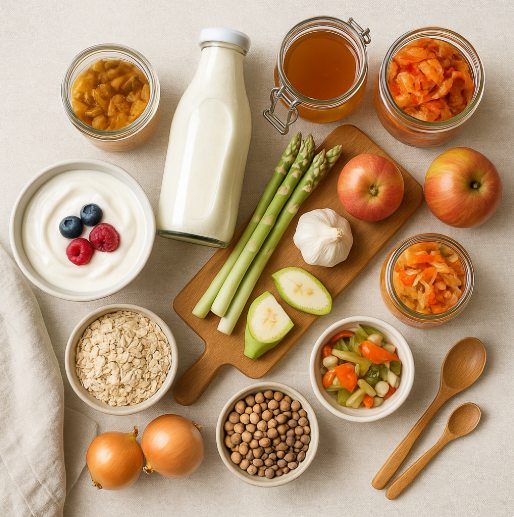Table of Contents
I wasn’t listening, when my stomach started speaking back. I wrote it off as a one-time incident, a rushed lunch and too much coffee. However, the uncomfortable bloating, the distended stomach and other related issues started to happen on every workday and even after dinner, and had become the norm. Sometimes happening even if I felt like I’d eaten healthy food. Coming across a sentence from a dietitian friend, ‘your gut isn’t just a pipe, it’s an ecosystem,’ completely changed my perception.
This was a turning point, not only how I see my body, my diet, I also started to get involved in what, where and how much I eat. If you’ve been weighing the decision of using a probiotic, knowing what feeds good bacteria or what on earth postbiotics are, this is going to be your go-to. Just to make it clear, I’m not a doctor, and neither is this a medical handbook. If you have a known digestive condition, allergies, or are on medication, have a word with your clinician or a registered dietitian before changing your routine.
Your microbiome, in plain English
When you look at the intricate ecosystem that is your gut, you’re seeing a teeming city of microbes, fungi, and a few viruses that all work together to break down the food you eat, train your immune system, produce vitamins and hormones, and send signals to your brain. Well-known examples of this balance can be seen in the body’s physical changes: steadier energy, calmer digestion, and regular bathroom days, and it all starts to go downhill when the gut community is lacking in diversity, or when it’s not fed, starved, and or out of balance.
When gut health is compromised, meals that used to be fine suddenly become toxic for you. And this community diet is about what you feed your gut day after day, and really gets to the root of what constitutes a healthy microbiome.
The three “biotics” you keep hearing about
Assessing gut health, I found a simple way to understand the roles of probiotics, prebiotics, and postbiotics. Think of them as a house guest, the menu they enjoy and the leftovers they leave behind. Probiotics are live microorganisms that, in sufficient amounts, give a host a health boost. This isn’t marketing jargon, it’s a serious statement made by experts, researchers, and government regulators. Any yogurt or capsule can’t just call itself a probiotic, the specific strain and amount must have been proven to be effective. A prebiotic is essentially a snack for the microorganisms that live in your gut, and confers a health benefit, with most people experiencing prebiotics as fibrous and aromatic compounds in whole plant foods such as onions, garlic, leeks, asparagus, chicory, legumes, and green-tinged bananas. However, its your gut microbes, and not you, that will digest them. Postbiotics are the remnants of microorganisms or their parts, yet they can deliver an active health benefit, often using inactivated microbes, there is a generic usage of “postbiotics” to refer to the metabolic waste of your microbes, which consists of the small molecules we can use to calm down inflammation and strengthen our gut lining.
Why fermented foods can feel like a shortcut
When I started incorporating a small amount of fermented foods into my diet, such as yogurt for breakfast, kimchi to go with my eggs and a dash of kefir in my morning smoothies, I noticed a marked decrease in what I call “food noise” and a much calmer stomach. It was a simple n=1 trial, which could be coincidence, but it has stuck and become a staple in my diet, which wasn’t an accident.
Coming across a 10-week Stanford study reinforced that diet rich in fermented foods would be the key. It found that such a diet resulted in a massive increase of good gut microbes and a substantial reduction of markers of inflammation in adults.
The quiet superpower of fiber and resistant starch
As for shortening the digestive process, fermented foods are the way to go, but fibre is basically the marathon runner. The daily recommended intake for fibre is 25 grams for women and 38 grams for men, or roughly 14 grams per 1,000 calories, and we all seem to be falling short. Well-known for feeding the good bacteria in our guts, a diet that’s high in fruits, vegetables, legumes, whole grains, nuts, and seeds is also filling the gap.
When we feed the microbes, they reward us with short-chain fatty acids, butyrate being one of the most beneficial. It acts as fuel for our colon cells, and also helps to fortify the gut lining and combat inflammation. Now, a peculiar type of fibre, resistant starch, is gaining recognition for its ability to resist digestion in the small intestine and reach our microbes intact. Green bananas, legumes and cooked and chilled rice and potatoes are all sources of resistant starch. Research suggests it not only modulates the microbiome and boost SCFA production but also has been associated with improved metabolism and bowel regularity.
In an example I find simple to follow, one just needs to make a big pot of rice, chill it, and reheat it gently. That’s a small, achievable way I have learned to increase the amount of resistant starch in my diet.
So…do you actually need a probiotic supplement?
Speaking of getting a healthy dose of probiotics, the best option is often found in the food you eat, where probiotics are naturally abundant and, usually, inexpensive. Coming to probiotic supplements, they can be effective in very specific situations. But, the American Gastroenterological Association reviewed the existing research on various digestive conditions and couldn’t find a lot of justification for general use of probiotics in the treatment or prevention of most GI disorders. There are, however, specific cases and strain-specific instances that may work.
For instance, using them as a prevention against certain infections, especially with antibiotics. When getting a probiotic supplement, look for one with a named strain, a suitable dosage and specific reason, and involve your doctor. Choosing products with third-party tested and listed, and viable counts that last all the way to the best before date. A somewhat under-examined safety aspect of probiotics, is that the yeast Saccharomyces boulardii can cause rare bloodstream infections in hospitalized people, those in critical condition, or those who are immunocompromised. If you’re not well or have lines in your body for medications or feeding, you will want to use this particular strain with care.
How prebiotics feel in real life
If you’re looking for a healthy dose of probiotics, eating a diet rich in probiotic-rich foods is the best option. Coming to supplements, they can be very effective in specific cases, but the American Gastroenterological Association looked over the available research on various stomach issues and basically didn’t find a strong justification for the general use of probiotics in the treatment or prevention of most GI problems.
However, there are particular instances and strains that have been proven to work. One example is in using them as a shield against infections that occur when taking antibiotics. When choosing a probiotic supplement, look for one with a named strain, the right dosage and a clear reason for its use, and talk it over with your doctor. Third-party testing and guaranteed viability up to the expiry date are also very important. The less well-known downside of probiotics, is that the yeast Saccharomyces boulardii can cause rare bloodstream infections in people in the hospital, those in critical condition or have weakened immune systems. If you’re not feeling well, or have lines in your body for medication or feeding, this particular strain should be used with care.
Postbiotics: the payoff you can’t see, but you can feel
When I’m eating I’m not just feeding myself, I’m feeding the trillions of microbes that live inside me, and they’re going to return the favor. Producing metabolites that will soothe my gut lining, calm my immune cells, and even send signals to get my bowels moving. Well-known postbiotics like SCFAs butyrate being one of them. Make sure that gut barrier stays intact and get rid of any unwanted toxins. Meals rich in diverse plants and a few fermented foods are consistently a part of my diet and now, as a result, I experience the benefits of postbiotics as a healthier digestive system, and not to mention less bloating, better formed stools, and fewer energy crashes.
A day on my plate, when my gut feels its best
Topped with fresh berries and a few walnuts, for breakfast, when I’m in a low-stress period I like to kickstart my day with a delicious combination of strained yogurt mixed with chia seeds and a spoon of kefir. Lunch often consists of a warm, comforting lentil-vegetable soup served over leftover, cooled-and-reheated rice with a side of tangy, sauerkraut, and my dinners are pretty straightforward. Either roasted salmon or tofu, garlicy greens and a baking sheet of roasted root vegetables. I sometimes graze on a green-banana-spinach smoothie blended with oats and cinnamon, or a square of dark chocolate with a few almonds, and that’s basically it. Coming back from a big social occasion that was heavy or boozy, I know I need a little bit of a boost, so I throw in some fermented foods and fibre the following day, and let things return to normal.
What to do when you feel worse before you feel better
As I started introducing fiber-rich foods I didn’t find it easy. Coming across the board with a blast of fiber made me feel bloated and uncomfortable. Coming to a gentler approach, adding one new food at a time, cooking my vegetables well and opting for milder fibres such as oats and overripe bananas really helped me get going. When I’m on the move, I’m more about sticking to the things I know will work rather than aiming for perfection, so I try to have one fermented food a day, two to three colorful veggies at every meal and a fibre-rich staple like beans or quinoa if I can get it.
If you’re considering supplements, a practical checklist
In terms of supplements, I view them as a toolbox, something that can be used on an as-needed basis. If antibiotics are prescribed to me, I check in with my clinician to see if a strain-specific probiotic is a good idea for both during and after the course of antibiotics. If I’m trying out a prebiotic powder, I always start low and go slow. Coming back too quickly to a very high dose isn’t going to be any more effective, and could potentially throw my microbes out of balance. I also recall the formal definition of “postbiotics”, that’s inactivated microbes, or parts thereof, that have actually been shown to be helpful. And finally, I don’t think supplements do the job, food does, they just fine-tune what’s already there.
How to begin, without overwhelming yourself
For changing your diet, why not give yourself two weeks to notice the difference, add a small daily serving of fermented foods and increase your fiber intake by five grams a day. This could be as easy as adding chickpeas to a salad or swapping in oats at breakfast. If you’re plagued by IBS or other GI issues you may want to think about a short-term low-FODMAP trial under the guidance of a dietitian. It may be life changing and the reintroduction phase is where the real magic happens, but should be done very carefully. It’s always a good idea to keep a simple notes app log to connect the dots you may otherwise miss.
The gut-brain whisper you learn to hear
They were quite a lot less obvious than I thought they’d be, when I started to notice the changes in my gut. Coming hotfooting home in the afternoons, I used to feel a bit irritable, but now I feel calmer. Well-known research has been piling up on how gut microbes can influence the immune system and the nervous system, and while I don’t need a detailed map of all the pathways, I can feel the impact. It’s funny, when I eat for my microbes they seem to talk back to me, telling me they’re happy and I notice a steady improvement in focus and mood.
The bottom line
When it comes to gut health, don’t look for a miracle cure, a magic bullet or a superfood, nor do you need to take everything out of your diet. All that is needed is a friendly alliance with the microorganisms inside you. They’ll be happy with a varied diet that includes lots of prebiotic rich foods, smaller portions of fermented foods that contain live probiotics, and lots of patience to let the postbiotic benefits build up. Well-known strains of probiotics, definitions of prebiotics and postbiotics, and respecting your own body are also key to this whole process. If you think of your gut as an ecosystem and not a war zone, your meals won’t be battles anymore, they’ll be a nice conversation that you’ll want to continue.



